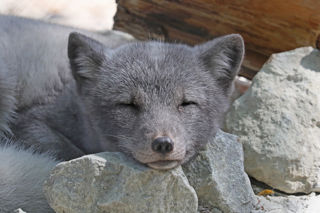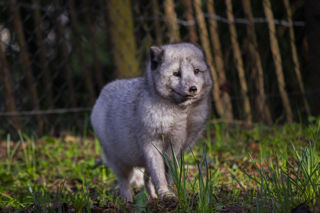
Arctic Fox
Vulpes lagopus
Arctic foxes are similar in size to a red fox, arctic foxes are highly adapted to extreme winter conditions famed for their thick, fluffy coat which they use for camouflage.

Miska & Aurora
Here at Wildwood we have two adult Arctic foxes; Miska and Aurora. Miska joined us in 2021 and Aurora in 2023. You can regularly see our foxes cuddled up sleeping outside in their enclosure. Be sure to visit in both winter and summer to compare their drastic coat transformation.
Read on for more insights into arctic fox characteristics and behaviours.

Habitat
Arctic foxes live in Arctic tundra, which are stark and open landscapes with few plants and mainly heathland. They can also be found in Arctic coastal areas free of ice.

Behaviour
Arctic foxes are active all year round, although they do move around less before winter in order to preserve fat reserves. Insulation in winter is dependent on these fat reserves which they build up during the autumn. Using their acute hearing and keen smell, arctic foxes can locate prey under the ice and pounce into the snow to catch them hidden beneath.

Threats
Climate change has historically affected the range and distribution of Arctic foxes. Hunting for furs has also been a long term threat; in recent years the fur hunting industry has declined, which means pressures have also subsided.
Competition and other associated problems (such as disease transmission, predation of kits, and interbreeding) with the presence of other species such as the red fox and domestic dogs is having a dramatic effect on some populations.
Distribution
Arctic foxes are found throughout the Arctic in tundra habitats within North America, Asia and Northern Europe.
Diet
Opportunistic predators and scavengers; arctic foxes eat anything smaller than them that they can get hold of. This can be heavily dependent on rodent populations (such as lemmings which is their main prey item). Birds, reindeer, grouse, seal, invertebrates and fish have also all been recorded as food items eaten by Arctic foxes.
Status
Arctic foxes were present in the UK at the time of the last Ice Age. As the climate warmed, and the ice receded, so did the range of the Arctic fox
Did you know?
The beautiful coat of the Arctic fox is the warmest of any animal in the Arctic. They can withstand temperatures down to -70°C.

